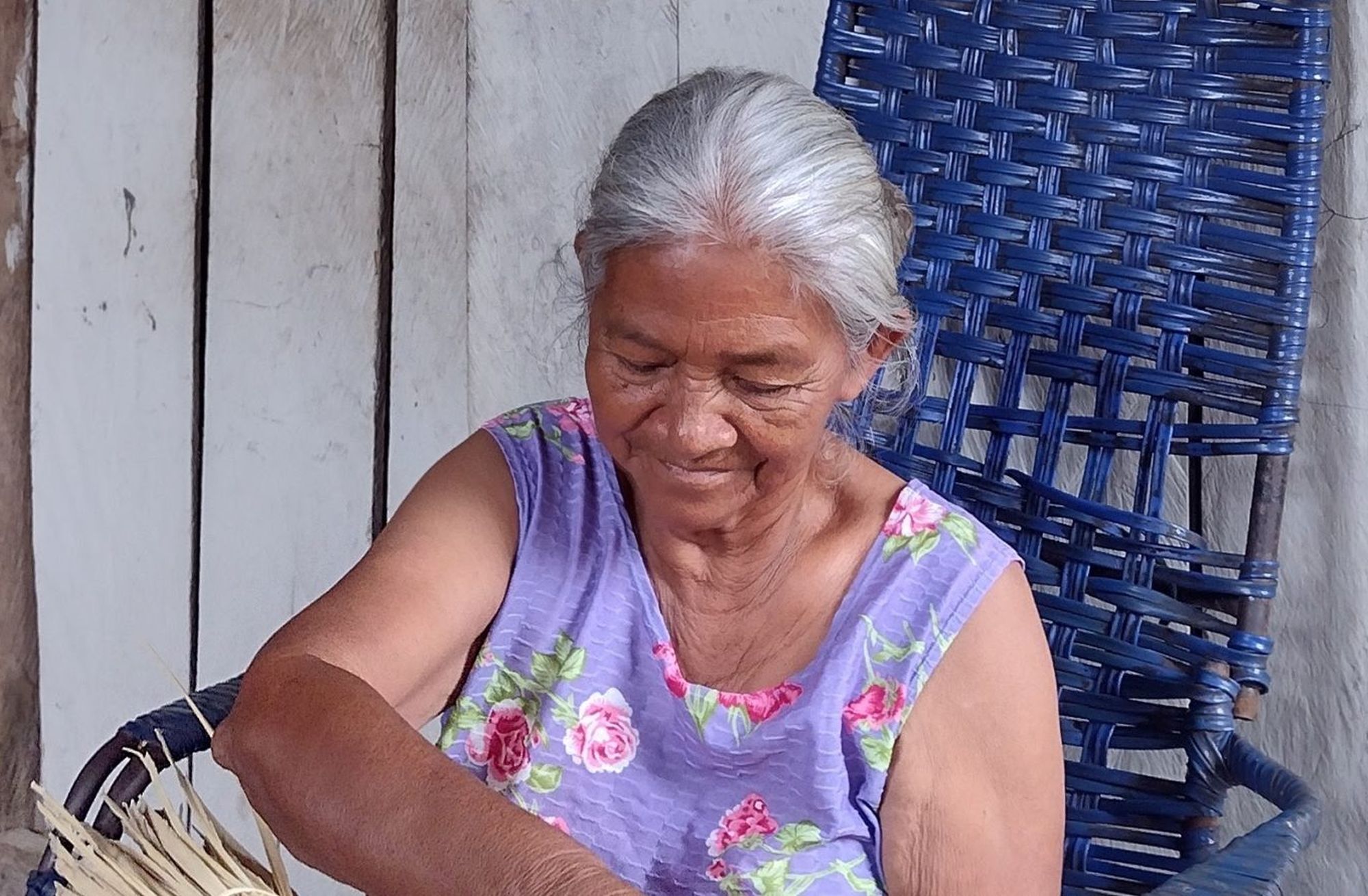The community of Deus é Pai (“God is our Father”) sits by the Tefé River in Brazil’s Amazonas state. As children play in a creek on a sunny afternoon, a woman speaks up for the traditional midwives of the Amazon Rainforest. She leaves a question in the air of this remote riverside village.
“I dare any specialist doctor to answer me. Would he deliver a child in a field, a canoe, a bathroom, or a flour mill?,” asks Tabita dos Santos Moraes. “Hey doctor, have you ever thought about helping a woman give birth in a dark room with no electricity? It’s just you with a flashlight on your head, your hands and the woman in labor?”
Moraes has been helping delivering babies since she was 15, and only recently left her position as president of the Algodão Roxo Association of Traditional Midwives in Amazonas (Aptam), the first and only group of its kind in the state.
Her grievances appear to be justified. Brazil’s Unified Health System (SUS) looks down on midwives. It doesn’t compensate them for expenses, and often blocks them from accompanying pregnant women undergoing labor in hospital — despite state legislation in Amazonas allowing them to do so as long as the woman requests it.
In railing against what she sees as the SUS’s short-sightedness and championing her colleagues’ skills, Moraes challenges the Western scientific paradigm that she says prevents them from doing their work. In much of the Amazon, where access to remote communities is difficult, especially during the dry season when the rivers dwindle to a trickle and boats are slow and unsafe, it’s the midwives who work on the front lines, helping pregnant women who have no other help.
“I don’t see a traditional midwife as being less than a doctor who went to university. Doctors have science and midwives have wisdom,” Moraes says. “I see us as a piece of the puzzle, just like health agents, assistant nurses, nurses and obstetricians. We are different, but we have our own place in the humanized childbirth team. We are doing our duty, so I ask those who hold power: look at us carefully.”
Moraes’s own experience is part of an oral tradition passed down by her mother, Joana Garcia, who is still active and has “pulled over a hundred bellies,” as the childbirth process is referred to here. She speaks about the struggle to keep alive this important ancient practice, which she says is being systematically erased as a form of knowledge by outside experts, and as an occupational category by the government.
Even though public policies exist for the official recognition and inclusion in health care services of midwives, they continue to be looked down on and sometimes threatened with lawsuits, which discourages many from registering with Aptam, the midwives’ association. There are an estimated 1,400 traditional midwives in Amazonas state, but only 500 have been identified by the association.
Maria das Dores is a member of Aptam’s board and a technician in the Quality of Life program run by the science ministry’s Mamirauá Sustainable Development Institute. Since 2000, the institute has promoted meetings with midwives in the Mid-Solimões River region. Dores herself has been a staunch supporter of the midwives’ association since seeing her mother quit the job for fear of retaliation if something went wrong during a delivery.
“Most of them are anonymous,” she says. “But many continue to do the job, regardless of the threats. When they are called on, they leave whatever they are doing and go help women where there is no health care service. Women discover their gift as midwives precisely in times of need.”
A key player when government is absent
Midwives play a crucial role in regions where the government is absent. Many have mastered a repertoire of techniques that are crucial for safe delivery in hard-to-reach areas. Without their practices — such as adjusting the position of the baby before birth, using plant-based medicines, and offering guidance on the best positions for the mothers — maternal mortality rates in Brazil would be even higher.
According to the World Health Organization, those rates have dropped from 143 deaths per 100,000 live births in 1990, to 63 per 100,000 in 2015. The latter figure is still high compared to industrialized countries, where the average is 12 deaths per 100,000 live births. Within Brazil itself, there are regional disparities in the maternal mortality rate. The northern, Amazonian states, are deadlier for birthing women, with Amazonas alone registering 108.4 deaths per 100,000 live births. Santa Catarina state in Brazil’s south has the lowest rate in the country, at 35.1 per 100,000.
For members of Aptam, sociologist Júlio César Schweickardt is something of a father figure, thanks to his support of the association, which was established in 2018. A researcher at the Oswaldo Cruz Foundation, or Fiocruz, Brazil’s leading public health research institute, Schweickardt has been a key player in pushing for midwives’ political engagement and creating spaces for dialogue at the municipal level with health care workers who are often unwilling to engage with the midwives.
The general resistance to midwives’ work is such that some municipalities require them to sign a letter stating that they assume all responsibility for anything that goes wrong during a delivery. This has created an atmosphere of fear and led to many deliveries being done in secret.
“This demand is violent,” Schweickardt says. “Instead of asking what they need, the municipalities shift all the responsibility to [the midwives]. There is a logic that sees delivery by midwives as risky. It reveals a bad legacy left by a hierarchy that places [Western medical] science above other types of knowledge. This needs to be demystified. C-sections are really risky.”
But Schweickardt says midwives are also gaining strength and raising their own voices, as in the case of the village of Iauaretê in the Upper Solimões Special Health District (DSEI), an Indigenous community with several ethnic groups where young midwives are attracted by a favorable environment that values their work.
“In this region, they are part of prenatal health care and receive money for expenses. About 53% of deliveries are performed by Indigenous midwives, so we can’t simply ignore them,” Schweickardt says.
He adds the profession isn’t regulated because municipalities require registered health workers to have academic training. For instance, traditional midwives can only work at hospitals if they have assistance nurse certificates, Schweickardt says.
“What we have been telling municipal governments is that they can hire midwives as community health agents or doulas to assist with deliveries,” he says. “What cannot happen is for them to keep working without pay, since there is no federal or state legislation allowing them to be paid.”
A holistic view of health
Among those working without pay is Sebastiana Pinto da Silva, who is registered with Aptam and works in the Barreira da Missão Indigenous Territory in the municipality of Tefé in Amazonas. An ethnic Ticuna community member, Silva says she’s proud to be a midwife, despite having been barred from the local hospital, where she says the care given to birthing mothers is less favorable than at home.
“It’s much better here. We make tea, we massage their legs and their backs. All with the greatest affection. It’s not like that in the hospital. They throw you there and sometimes they won’t even check on you. One of my daughters had the baby all by herself in the hospital’s bathroom,” Silva says.
Dávila Corrêa, the management and development director at the Mamirauá institute, has been following the organization of midwives for years. She says she sees their meetings with municipal health departments as the space for reconfiguring their role under the SUS and creating greater acceptance for different views on health care.
“This exchange is interesting because the midwives bring the holistic approach, which is a view of health as whole, including concern for the environment, such as growing a plant, taking care of the family,” says Corrêa, a sociologist. “On the other hand, public agents bring the important biological aspects to the debate, such as clean delivery, hygiene.”
She says midwives’ work as mediation agents is already reframed when they refuse to accompany pregnant women who have not undergone proper prenatal care and refer them to hospital. “Midwives take on this role in a subtle and sensitive way. They play an important role in the support network.”
As for the future, Corrêa says the passage of knowledge through oral tradition, from mother to daughter, grandmother to granddaughter, will never end. “Studies show continuity between generations. That’s why midwives’ work with the association legitimizes the existence of these women. Even if they are not delivering in the community, they are taking care of [the community’s] health as a whole, especially the psychological side.”
Schweickardt says that in the course of building bridges and channels for dialogue, the teaching legacy of traditional midwives is key: “Hospital childbirth is reduced to biological delivery. That’s involution. Midwives’ view of symbolic birth goes further and encompasses the idea of cultural birth. It has to do with the child being placed into a social body and its values. And midwives do it like no one else.”
This article appeared originally in Mongabay. Read the original article here: https://news.mongabay.com/2022/08/in-brazils-amazon-traditional-midwives-push-for-greater-recognition/






